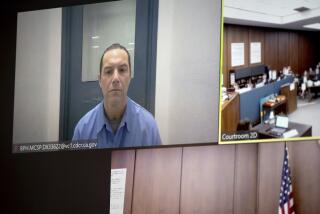DNA helps identify severed legs found in 2003 as Temecula woman’s; husband arrested

No one reported Laurie Diane Potter missing. San Diego County authorities used DNA and genetic genealogy to identify her remains.
Her name was Laurie Diane Potter. She was 54. The legs found in a trash bin in Rancho San Diego in 2003 were hers.
No one ever reported the Temecula resident missing. It took 17 years, DNA, genetic genealogy and determined sheriff’s detectives to discover who she was.
And, sheriff’s officials announced Friday, they have arrested her husband on suspicion of murder.
Jack Dennis Potter, 68, was arrested Wednesday outside his home in Rancho Cucamonga. He remained jailed without bail Friday.
San Diego County sheriff’s officials released the couple’s names Friday. They asked that anyone who may have known the couple anytime from the mid-1980s onward to come forward.
The Sheriff’s Department has started using investigative genetic genealogy, which often involves taking crime scene DNA from an unknown person and trying to match it with family members who have uploaded their DNA into publicly accessible databases. It’s how authorities identified the Golden State Killer in 2018.
Genetic genealogy is usually used to identify a suspect. Potter’s case marks the first time a law enforcement agency in San Diego has used the method to identify a victim.

On Oct. 5, 2003, a pair of women’s legs were found in a trash bin at an apartment complex near Hilton Head and Jamacha roads. But the remains could not be identified and the case went cold.
Fast forward to June 2020, when the sheriff’s cold case team decided to revisit the case. They worked with the crime lab and the county coroner. Detectives did the genealogy work.
They entered the DNA from the legs into public databases and found similar DNA from a distant relative also in the database. That allowed them to start building a family tree to find the common ancestor between the victim and the relative.
In this case, the family tree went back into the 1800s, lead Det. Troy Dugal told reporters at a news conference. Once they had that common ancestor, detectives built the tree forward.
Along the way, Dugal said, they contacted about 20 people in the victim’s family tree who agreed to share their own DNA to help detectives figure out her name. Six months later, in December, they found Potter’s adult son and determined that the legs were hers.
Once detectives knew their victim’s name, the traditional work of a homicide investigation began.
“We went back through her life and tried to identify who she was and where she was living, who were her friends and family during that time frame,” homicide Lt. Tom Seiver told reporters.
Detectives did not say what they think happened, or how they think Potter was killed, citing the ongoing investigation. But, Seiver said, they developed “substantial cause to believe that Jack Potter had murdered Laurie Potter.”
It is unclear when Jack Potter will be arraigned.
As of now, the sheriff’s cold case unit is actively investigating four or five other cases using genetic genealogy.
Anyone with information about Potter’s case was asked to call the Sheriff’s homicide unit at (858) 285-6330 or after hours at (858) 565-5200.
Anonymous tips can be left by calling Crime Stoppers at (888) 580-8477, or online at sdcrimestoppers.org.
More to Read
Start your day right
Sign up for Essential California for news, features and recommendations from the L.A. Times and beyond in your inbox six days a week.
You may occasionally receive promotional content from the Los Angeles Times.







